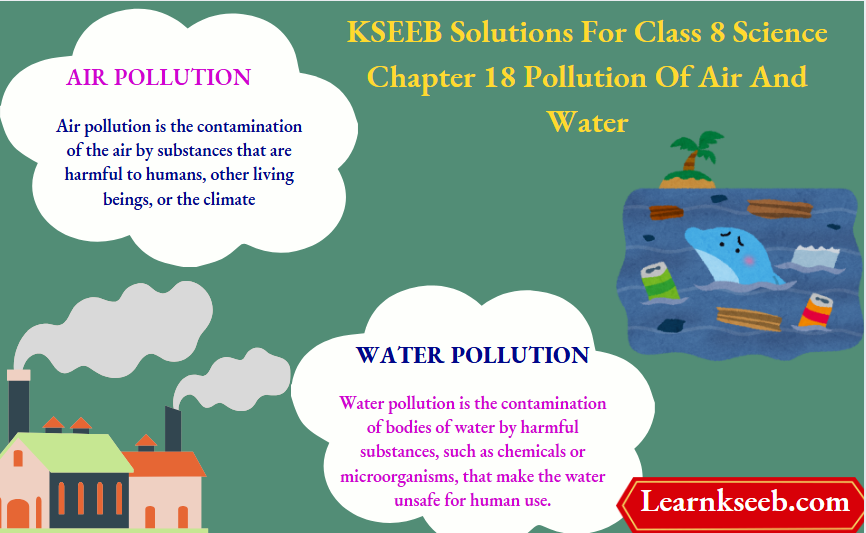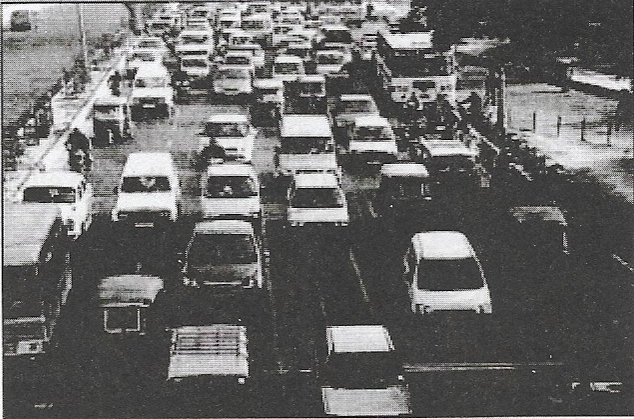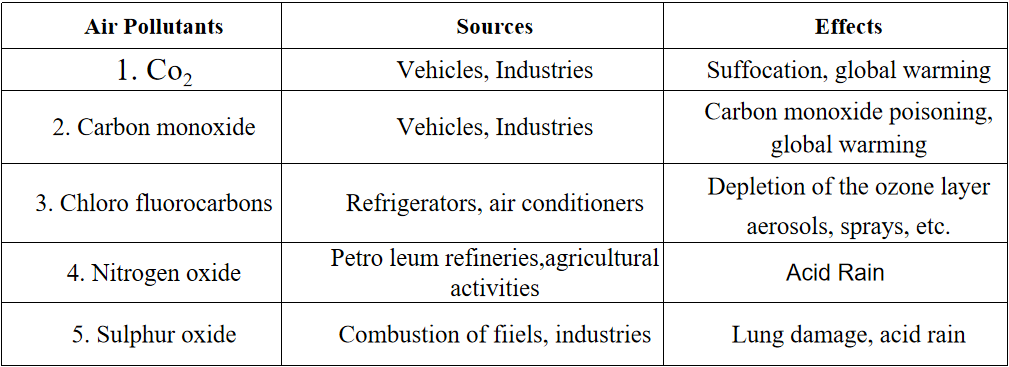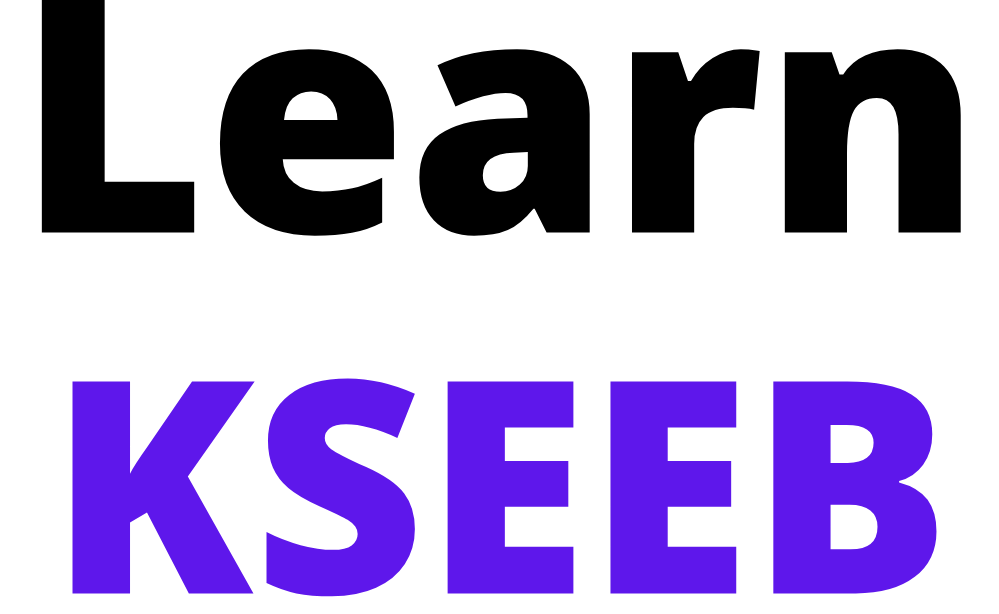KSEEB Solutions for Class 8 Science Chapter 18 Pollution Of Air And Water Points To Remember
Pollution: An undesirable change in the physical, chemical or biological characteristics of air, water and land that may be harmful to human life and other animals living conditions, industrial processes and cultural assets.
Pollutants: The agents that pollute our environment are called pollutants.
Pollutants are the substances which contaminate air, water, and land, For eg. smoke, dust fog and gases like sulphur dioxide and nitrogen dioxide. Air pollution is the contamination of air by impurities which may have a harmful impact on living organisms and non-living components.
Sources of Air Pollution:
Natural Sources: Smoke and dust arising from forest fires or volcanic eruptions. Methane gas arising from decaying organic matter, Man-made
Sources: Exhaust gases from factories, power plants and automobiles.
Carbon monoxide, nitrogen oxides, carbon dioxide, methane and sulphur dioxide are the major pollutants in the air. Smog is a mix in air of smoke and chemicals with fog. The chemical components of smog can include ozone, sulphur dioxide, nitrogen dioxide and carbon monoxide. Smog can trigger breathing difficulties like asthma and coughing.
Steps to prevent air pollution:
Use of fuels like CNG and unleaded petrol in automobiles. Switching to alternative fuels, like solar energy, hydropower and wind energy.
Planting trees. Travelling to school on a bicycle or on public transport or carpooling. Avoiding the burning of leaves, trash and vegetable matter Restricting cigarette smoking. Increasing levels of greenhouse gases like CO, and CEC (Chlorofluorocarbon) are leading to global warming. Excessive use of CFCs damages the ozone layer which protects the earth from harmful UV rays emitted by the sun.
Greenhouse Effect and Global Warming:
The sun’s rays warm the earth’s surface. A part of the radiation that falls on the earth is absorbed by it and a part is reflected back into space. A part of the reflected radiation is trapped by the atmosphere due to the presence of gases like water vapour, carbon dioxide, methane, nitrous oxide etc known as greenhouse gases. This is known as the greenhouse effect.
The trapped radiations further warm the earth and have adverse effects such as the melting of glaciers and increasing sea levels. This phenomenon is
known as global warming.
Water pollution is the contamination of water by objectionable and harmful substances such as sewage, toxic chemicals, silt etc.
Sewage, agricultural chemicals and industrial waste are some of the major contaminants of water.
Water which is purified and fit for drinking is known as potable water. Water is a precious natural resource. We must learn to conserve it.
Class 8 Science KSEEB Pollution of Air and Water Notes

Kseeb Solutions For Class 8 Science Chapter 18 Pollution Of Air And Water Pdf
Pollution Of Air And Water NCERT Textbook Exercises
Question 1. What are the different ways in which water gets contaminated?
Answer: Water gets contaminated due to the addition of substances harmful to health. Sewage, agricultural chemicals and industrial wastes are some of the major contaminants of water.
Question 2. At an individual level, how can you help reduce air pollution?
Answer: At an individual level we can help in reducing air pollution by following methods:
1. We can plant trees and nurture the ones already present in the neighbourhood.
2. We can take part in Van Mahotsava actively and effectively every year and motivate people about the importance of plantation.
3. We can educate people against burning dried leaves and plants and advise them to put them in a compost pit.
Question 3. Clear, transparent water is always fit for drinking. Comment
Answer: No clear and transparent water even without smell, may contain bacteria, viruses etc. which are not visible to the eyes. Drinking such water can cause illnesses of various kinds. Therefore, we must drink purified and potable water after boiling.
Question 4. You are a member of the municipal body of your town. Make a list of measures that would help your town to ensure the supply of clean water to all its residents.
Answer: The following steps could be taken:
1. First of all procurement of the required amount of water for all residents should be ensured.
2. Wastage of water by leakage at various places should be taken into account.
3. Water treatment should be ensured.
4. Must have sufficient water tanker to meet emergency situations.
Karnataka Board Class 8 Science Chapter 18 Solutions
Question 5. Explain the differences between pure air and polluted air.
Answer: Pure air is free from any pollutants has no smell, is soothing and not irritating to the eyes. Whereas polluted air gives a filthy smell and people cannot breathe in it. If people inhale such air, they may suffer from various breathing, heart and lung problems. Even sometimes people die from inhaling polluted air.
Question 6. Explain the circumstances leading to acid rain. How does acid rain affect us?
Answer: Gases like sulphur dioxide and nitrogen dioxide react with water vapour present in the atmosphere to form Sulphuric acid and nitric acid. These acids come down with rain water, making the rain acidic. This is known as acid rain. Acid rain corrodes the marble of the monuments. This phenomenon is known as Marble Cancer. It also kills the useful organism in agricultural soil.
Question 7. Which of the following is not a greenhouse gas?
1. Carbon dioxide
2. Sulphur dioxide
3. Methane
4. Nitrogen
Answer: 2. Sulphur dioxide.
Question 8. Describe the ‘Green House Effect’ in your own words.
Answer: The Sun’s rays when fall on the earth’s surface, get warm. Some of the Sun’s rays are trapped by the atmosphere and these and not allowed to go out of the earth’s atmosphere. This trapped heat cause warming of the atmosphere called the greenhouse effect. The gases like methane and carbon dioxide form a thick layer and prevent the escaping of heat causing this effect. Due to the greenhouse effect, global warming is happening.
Question 9. Prepare a brief speech on global warming. You have to deliver the speech in your class.
Answer:
1. Today, global warming has appeared as one of the most severe threats to human beings. On one hand, carbon dioxide is added to the atmosphere due to human activities. On the other hand, the forest area is decreasing day by day. It leads to an increase in the amount of carbon dioxide in the atmosphere. The accumulation of this gas causes the greenhouse effect and global warming.
2. Global warming can create the melting of ice of icebergs, resulting in a rise in the sea level and causing the flooding of many coastal areas. So, we must be aware of this problem and take every possible step to tackle it
Question 10. Describe the threat to the beauty of the ‘TajMahal
Answer: The Taj Mahal is made of white marble which is getting affected adversely due to the industrial pollutants from Agra, Mathura etc. the sulphur dioxide gas along with nitrogen oxide gas released from these industries mix with rainwater to form Sulphuric acid that falls on the marble of this monument. The acid rain corrodes the marble and makes it yellowish. This is a matter of great concern that world-famous monument like the Taj Mahal may get damaged due to the pollutants emitted by factories
around it.
Question 11. Why does the increased level of nutrients in the water affect the survival of aquatic organisms?
Answer: Agriculture relies on the use of chemical fertilizers to improve crop yield. All these chemicals dissolve in water and run into water bodies from the fields. These seep into the ground and pollute the groundwater. A lot of algae in the ponds grow and keep the ponds green. This is caused due to excessive quantities of chemicals like nitrates and phosphorous present in fertilisers. Excessive growth of algae decreases the oxygen level at water bodies and kills the other aquatic animals living inside it.
Pollution Of Air And Water Class 8 Kseeb Solutions With Answers
Pollution Of Air And Water Activities
Question 1. You may have covered your nose while passing a brick kiln emitting smoke or started coughing while walking on a busy road

On the basis of your experience, compare the quality of air at the places given below: A park and a busy road.
A residential area and an industrial area.
A busy traffic intersection at different times of the day, e.g., early morning, afternoon and evening.
A village and a town.
Answer: When we visit a park we find it full of fresh air and on a busy road we find it polluted due to fumes, smoke, dust and sound.
An industrial area is more polluted as compared to a residential area as an industrial area gets polluted with chemical pollutants, toxic gases, etc. Early morning there is less pollution but in the afternoon it becomes a little more polluted than in the morning and in the evening it becomes extremely polluted. A town is more polluted than a village.
Question 2. Prepare a table using the pollutants mentioned above You may even add more data to the following Table
Answer:

Kseeb Class 8 Science Pollution Of Air And Water Exercise Solutions
Question 3. You have various options of commuting to your school such as walking, going by bicycle, travelling by bus or other public transport, using a car individually, travelling by carpool. Discuss in your class the impact of each of these options on the quality of air.
Answer:

Question 4. Try to collect samples of water from a tap, pond, river, well and lake. Pour each into separate glass containers. Compare these for smell, acidity and colour. Complete the following Table.
Answer:

Karnataka Board 8th Science Chapter 18 Important Questions And Answers
Question 5. You investigated the sewage disposal system of your locality in Class VII. Do you remember how the sewage was collected from your home and where it went thereafter?
Answer: The underground network of small and big pipes called sewers carry the sewage from the point of production to the point of disposal, i.e., the treatment plant.
Question 6. Let us construct a water filter with simple, everyday materials.
Take a plastic bottle and cut it into 2 halves at the centre. Use the upper half as a funnel by putting it upside down in the lower half. Make layers in it with a paper napkin or a fine cloth followed by, cotton, sand and then gravel. Now pour dirty water through the filter and observe the filtered water.
Discuss the following questions amongst yourselves and with your teacher:
Why do we need to filter water before drinking?
Where do you get your drinking water from?
What will happen if we drink polluted water?
Answer:
1. Water which is full of dust particles and impurities is unfit for human health thus we need to filter water before drinking it.
2. We get drinking water from the government supply water or hand pump.
3. Polluted water has disease-carrying microorganisms and dissolved impurities which can make us seriously ill.
Pollution Of Air And Water Class 8 KSEEB Questions And Answers
Pollution Of Air And Water Additional Questions
Question 1. What is the full form of CFC?
Answer: CFC — Chloro fluoro carbons
Question 2. What is meant by air pollution?
Answer: The presence of unwanted substances in the air which have a harmful effect on living and non-living components is known as air pollution.
Question 3. What name is given to unwanted substances present in the air?
Answer: Air pollutants.
Question 4. What are the harmful effects of smog?
Answer: Smog Causes breathing diseases such as asthma, cough and wheezing in children.
Question 5. How are CFCs added to the atmosphere?
Answer: CFCs are released from aerosol sprays, refrigerators and air conditioners.
Question 6. Name one important monument which has been affected by air pollution.
Answer: Taj Mahal is located in Agra.
Question 7. Expand SPM..,
Answer: Suspended Particulate Matter.
Question 8. Name some greenhouse gases.
Answer: Carbon dioxide, methane, nitrous oxide and water vapour.
Question 9. What is meant by polluted water?
Answer: Whenever substances such as sewage, toxic chemicals, silt, etc. which are harmful to life, get mixed with water, the water is said to be polluted.
Question 10. What is potable water?
Answer: Water which is suitable for drinking is called potable water.
Kseeb Class 8 Science Chapter 18 Textbook Solutions Pdf
Question 11. What is rain mixed with sulphuric acid called?
Answer: Acid rain.
Question 12. Name two smokeless fuels.
Answer: LPG and CNG.
Question 13. Name three diseases caused by polluted water.
Answer: Diarrhoea, dysentery and jaundice.
Question 14. What is Marble Cancer”?
Answer: Due to the acid rain the marble of the Taj Mahal has become yellow and is degrading. This is known as Marble Cancer”.
Question 15. Why is the greenhouse effect called so? How does it cause global warming?
Answer: It is called so because the earth’s atmosphere acts like a greenhouse made of glass in which sunlight enters through the transparent glass but the heat released by plants m the form of infrared radiation is not allowed to escape. Carbon dioxide does not allow heat to escape causing global warming.\
Explanation Of Pollution Of Air And Water In KSEEB Science
Pollution Of Air And Water Multiple Choice Questions
Question 1. Air is a mixture of various gases. One of the gases is 21% part of the air and is essential for the survival of human beings. This gas is
1. Nitrogen
2. Oxygen
3. Ozone
4. Argon
Answer: 2. oxygen
Explanation: Nitrogen-78.09%
Ozone-0.000004%
Argon- 0.93%
Question 2. Which of the following is not a source of air pollution?
1. Automobile exhaust
2. Burning of firewood
3. Windmill
4. Power plant
Answer: 3. Windmill
Explanation: Windmill will not release any sort of gas into the atmosphere hence it is not considered a source of air pollution.
Question 3. Boojho wishes to contribute to reducing air pollution. Which vehicle should he use for going to school?
1. Car
2. School bus
3. Autorickshaw
4. Scooter
Answer: 2. School bus
Explanation: School buses carry many students hence reducing the emission. This will reduce air pollution.
Question 4. Which of the following is not a way to conserve water?
1. Replace
2. Reduce
3. Reuse
4. Recycle
Answer: 1. Replace
Explanation: Reduce, reuse and recycle is the formula to conserve natural resources. Replacement is not the way to conserve water.
Question 5. The type of pollution which is likely to affect the Taj Mahal in Agra to a greater extent is
1. Air pollution
2. Water pollution
3. Soil pollution
4. Noise pollution
Answer: 1. Air pollution
Explanation: Air pollution caused by residues from the nearby factory is causing damage to Tajmahal by converting white marble to yellow.
Question 6. Incomplete combustion of fuel such as petrol and diesel gives
1. Nitrogen oxide
2. Sulphur dioxide
3. Carbon monoxide
4. Carbon dioxide
Answer: 3. Carbon monoxide
Kseeb 8th Standard Science Chapter 18 Notes And Solutions
Question 7. The phenomenon of marble cancer is due to
1. Soot particles
2. CFCs
3. Fog
4. Acid rain
Answer: 4. Acid rain
Explanation: Marble cancer is the phenomenon of corrosion of buildings and monuments due to the effect of acid rain.
Question 8. Potable water is the water which is
1. Obtained from a river.
2. Obtained from a lake.
3. Pure and fit for drinking.
4. Used only for washing clothes.
Answer: 3. Pure and fit for drinking.
Question 9. Which of the following procedures will give you water free from all impurities?
1. Adding chlorine tablets
2. Distillation
3. Boiling
4. Filtration
Answer: 2. Distillation
Question 10. A pond contains clean water. Which of the following activities will produce the least pollution of water?
1. Washing clothes in the pond
2. Animals bathing in the pond
3. Washing motor vehicles in the pond
4. Swimming in the pond.
Answer: 4. Swimming in the pond.
Question 11. Trees help in reducing the pollution of our environment. Lakhs of trees are planted by people in the month of July every year. The occasion is called
1. Forest Conservation Day
2. Plantation month
3. Van Mahotsav
4. wildlife week
Answer: 3. Van Mahotsav
Question 12. Which of the following is not a greenhouse gas?
1. Nitrogen gas
2. Water vapour
3. Methane gas
4. Carbon dioxide
Answer: 1. Nitrogen gas
Explanation: A gas that contributes to the greenhouse effect by absorbing infrared radiation is known as a greenhouse gas. Nitrogen is a part of atmospheric gases and it will not contribute to the greenhouse effect.
Question 13. Name the chemicals which are used in refrigerators and air conditioners and damage the ozone layer when released in the air.
Answer: Chlorofluorocarbons.
Question 14. Name any two sources which cause air pollution due to suspended particulate matter.
Answer:
1. Combustion of fuel
2. Industrial activities
Question 15. Name two gases which are mainly responsible for acid rain.
Answer:
1. Sulphur dioxide
2. Nitrogen dioxide
Question 16. The quality of air at various locations is monitored regularly by the government and other agencies? In what way can you use these data?
Answer: These data can be used to generate awareness about air pollution among people.
Question 17. The combustion of fossil fuels generates a lot of air pollution. Can you suggest any two alternative sources of energy which do not cause any pollution?
Answer: Solar energy and wind energy.
Step-By-Step Solutions For Pollution Of Air And Water Class 8 Karnataka Board
Question 18. Name any two water pollutants which are toxic for plants and animals.
Answer: Lead and Arsenic
Question 19. A lot of dry leaves are collected in a school garden and are burnt every day. Do you think that it is right to do so? If not, what should be done to dispose off the dry leaves?
Answer: Burning dry leaves is not the right thing to do as it causes air pollution. Converting dry leaves is the right thing to do as it does not cause any pollution and also gives manure.
Question 20. The level of air pollution is higher at a busy traffic intersections. Why?
Answer: Explanation: At traffic intersection automobiles stop for a while which lead to the accumulation of harmful gases at the junction. Hence the level of air pollution is higher at a busy traffic intersections.
Flow Chart

Karnataka State Board Syllabus for Class 8 Textbooks Solutions
- Chapter 1 Crop Production and Management
- Chapter 2 Microorganisms: Friend and Foe
- Chapter 3 Synthetic Fibres and Plastics
- Chapter 4 Materials: metals and Non-Metals
- Chapter 5 Coal and Petroleum
- Chapter 6 Conservation of Plants and Animals
- Chapter 7 Force and Pressure
- Chapter 8 Friction
- Chapter 9 Sound
- Chapter 10 Combustion and Flame
- Chapter 11 Cell Structure and Functions
- Chapter 12 Reproduction in Animals
- Chapter 13 Reaching the age of Adolescence
- Chapter 14 Chemical Effects of Electric Current
- Chapter 15 Some Natural Phenomena
- Chapter 16 Light
- Chapter 17 Stars and the Solar System
- Chapter 18 Pollution of Air and Water
